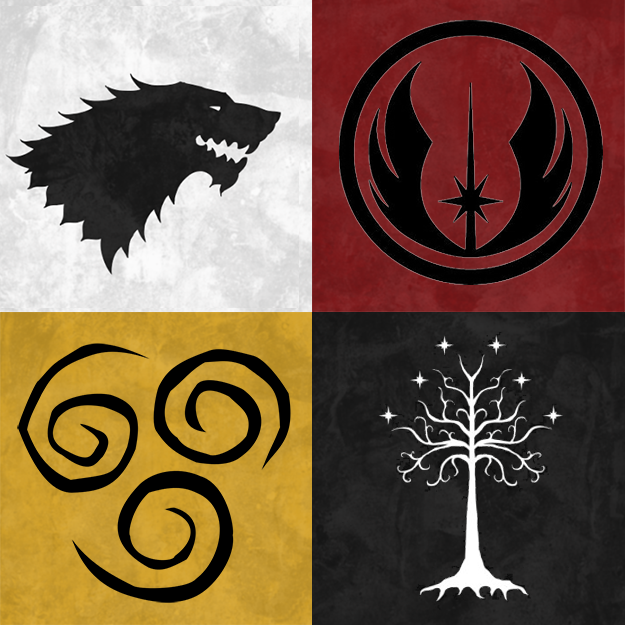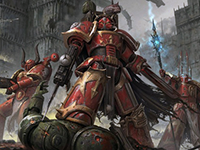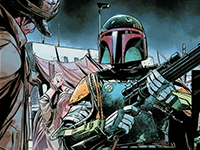Raise the banners! … Today, we’re going to learn about factions; what makes a faction, the types of factions, and how to build factions for your storytelling, tabletop, and world building needs. …

Organizations make up the world we live in, whether it real or fiction. … Guilds. Governments. Corporations. Secret societies. Holy orders. Adventuring parties. Alliances. Gangs. … You name it!
These factions determine the balance of power, the management of resources, and the spread or preservation of culture and ideals. In fantasy and science fiction, they give the story a sense of conflict, politics, and order. In table-top game worlds, they provide our intrepid adventurers something to interact with, build a reputation in, or something large to oppose ….
What is a faction?
Put simply, a faction is a group of people with a unified purpose. They are a social structure of many individuals with a common goal, much like an organization. What makes a faction different, however, is the element of ‘conflict’.
Factions exist in worlds that are consumed in struggle, where one is forced to compete for resources, compel the populace, or fight for its survival. Those in a faction stand opposed to forces that pose a threat to the goals of the group. They are segments of a population, unified because of, or despite, conflict.
This is not to say that a faction can’t be peaceful, or focused on things like commerce, religion, or a passive shared interest. However, the world they exist in is likely to be one filled with threats to overcome.
Any faction good enough for a story will have deep lore, motivated members, goals with clear stakes, and some personality to spare!

What are the different types of factions?
In order for a faction to exist, there has to be a reason for people to organize themselves. They need a unifying purpose or goal. These goals can be:
- Military – Armies of battle hardened soldiers, knightly orders, revolutionaries, and mercenary companies. All manner of combat finesse, discipline, rigid structure, and a motivation to fight and defend the interest of the group by force.
- Religion – Religious faiths, spiritual sects, cults, and holy orders. Spreading the faith, preserving tradition, converting unbelievers, and protecting against the interlopers and the faithless.
- Political – Emperors and kings, parties of ideologues, radicals and loyalists, aristocracy, traveling ambassadors, peace-keepers, and the corrupt. Those with the power to make administrative impact on a nation or region.
- Economic – Trading companies, merchant guilds, multi-national corporations, industry, and labor groups. All that glitters may not be gold, but it might as well be.
- Guild – Groups spanning all trades and professions, from gunsmiths to armorers, tailors to tanners, crafters and architects. Not to mention bards, lore-keepers, artists, curators, and the keepers of other secrets.
- Cultural Identity – Peoples bound together by ethnicity, class, societal status, region, traditions, and cultures. Birds of a feather flock together, and so fly their struggles, interests, and the passing on of their way of life.
- Figurehead / House – Charismatic leaders, wealthy elites, and prophets. Some individual rise to become great, and in their wake, stands a legion of followers who serve under their banner alone.
- Criminal – Pirates, town and city gangs, assassins and thief guilds, and those exiled from society. The world is filled with places for plunder, profit, and secrecy.
Some assembly required.
Granted, not all factions break down into nicely fit categories. Most factions cover multiple of these facets. A religious sect might be surrounding a prophetic figurehead. A military group might also be bound together by a specific cultural identity, whether it be region, ethnicity, class, ideology, or similar concept.
Perhaps a group of trades-people want to regulate the kind of work they do within a city, and also use criminal means to push out rivals. Maybe an exiled regiment of the emperors army has established itself in a lawless province and vies to thwart the throne for its own rule. A shadowy group of outcasts turned warrior-monks follow the teachings of a sage who preached about the tenuous balance of life and death.
Examples of Factions:
There are countless examples of factions that exist in pop culture, speculative fiction, and games. Enjoy some cherry-picked examples:
- Lord of the Rings tells the story of a ring bearer, for whom a Fellowship is founded, among the elves of Rivendell. Meanwhile Sarumon’s Army (defined by a white hand) scower the countryside. Later, Gondor is under assault by the armies of Mordor, as Rohan comes to their aid.
- A Song of Ice and Fire (Game of Thrones) is a story centered upon a series of unrelenting conflicts between House Stark, House Lannister, House Baratheon, and House Targaryen, with several lesser houses, bands, and tribes also in tow.
- Star Wars has a wide array of factions over the franchise; Jedi vs Sith, Trade Federation vs The Republic, Empire vs Rebellion, First Order vs Resistance. … Not to mention the Mandalorian Clans, Tusken Raiders, the Hutts, and several others.
- Dungeons and Dragons lore (Forgotten Realms) is filled with great city-states, kingdoms, and territories which vie for their own interests. There are also exclusive (and elusive) factions such as the Lords Alliance, the Emerald Enclave, the Zhentarim, and several others.
- Avatar, the Last Airbender has four dominant factions; Earth Kingdom, Fire Nation, Water Tribe, and Air Nomads. Each are colorful, culturally unique, and devout to their teachings of the art of bending the elements.
- Harry Potter is a story of witchcraft and wizardry. In the school of Hogwarts, one can be a Gryffindor, a Ravenclaw, a Hufflepuff, or a Slytherin. Other groups also exist that make up the wider magical world.
- Marvel Comics is filled with various factions, but most famously focused on the heroism of “The Avengers”, Earths mightiest heroes. This universe includes groups like SHIELD, Hydra, the Children of Thanos, the Guardians of the Galaxy, the Marauders, the Ten Rings, etc.
- The Fallout game series is set in multiple locations, but some notable factions and organizations are the Brotherhood of Steel, the Enclave, the NCR, Caesars Legion, the Institute, the Railroad, the Minutemen, … and don’t forget… another settlement needs your help!

Looking to receive updates on NEW articles, NEW resources, and NEW random name generators from Chaotican Writer? Subscribe to the weekly newsletter and get a FREE 11-page Fantasy NPC Generator PDF!
How to build a faction (Some questions)
Now that we have some examples, let’s break down the process of building a faction. Like all other aspects of world-building, there is no one-size-fits-all method to accomplish this. However, one way is to look at each of its parts, and ask ourselves some important questions in order piece our faction together bit-by-bit. … Let’s get started!

Armies of Rohan (Lord of the Rings)
Faction Name
The grand label of the group. This includes their official name, a shorthand name, and any nicknames.
- What binds them together?
- What symbolism do they use?
- Do outsiders use nicknames that, when said, others understand immediately who they are speaking about?
- Any insulting or derogatory names?

Various villains of Waterdeep
(Dungeons and Dragons)
Goals and Motivations
Factions must have specific goals they are trying to accomplish in order to serve a purpose to its members.
- What is the mission of the faction?
- What in the world do they seek to change?
- Are they motivated by power, money, or faith?
- Do they work for societal benefit, or for themselves?
- Perhaps the story is different depending on which member, or the outsider you speak to?

Chaos Space Marines
(Warhammer 40k)
Organizational Structure
Each member has its calling, serves a crucial role, and exists within a structure that binds them together.
- What are the ranks of its members?
- What member roles does the faction employ?
- Who is the faction leader?
- How does the leader represent the group?
- What concepts and ideas unify the group?
- How does the faction obtain and regulate its supplies?
- Is the structure of the faction a hierarchy, a collective, a people?
- Is it based upon honor, merit, societal status, wealth, savagery, works, or something else?

Captain America vs Ironman
(Marvel Comics)
Conflict and Rivals
In order for a faction to stand, it must stand for or against something. This will no doubtingly mean the presence of conflict, rivals, and other forces in opposition.
- Who are the factions rivals?
- What separates the faction from those outside of it?
- What challenges or obstacles stand in the way of its goals?
- How does its goals come into conflict with others?
- What is the factions relationship with outsiders?
- What is the factions relationship with its rivals?

The Speakers (Castlevanya)
History and Lore
Many years of chronicling have given your faction an identity paved by its past, setting its course for the future.
- What is the origin of the faction?
- How did its members unify, and what keeps it going?
- What challenges did it encounter on its journey?
- What story does it tell about itself?
- What story do others tell about it?
- What was the faction like in its youth, peak, downfall, etc?
- How does its history define its present?

Boba Fett (Star Wars)
Reputation
The actions of your group echo throughout the universe, and carve their image in the eyes of those around them.
- What kind of reputation does the faction have?
- What actions have driven its reputation in the world?
- What do those in the faction think about the faction?
- What do outsiders think about the faction?
- What do its rivals think about the faction?

Earth Kingdom
(Avatar: The Last Airbender)
Symbol and Colors
Every faction has a symbol; something to recognize them by sight alone. Its people wear clothes that identify them as a member, and the colors and symbolism used help unify them. Banners, trinkets, tools, and other items may also have this symbol prominently displayed.
- What does the faction logo look like?
- What colors does the faction employ?
- What symbols does the faction use to identify itself?
- What is the meaning of that symbolism?
- How does its colors and symbols tell the story of the faction?

Ned Stark
(A Song of Ice and Fire)
Faction Motto
- What is the faction motto?
- What is the meaning of the motto?
- Does it have any hidden meaning?
- When and where does this motto appear?

Rowdy Crew
(Magic the Gathering)
Personality and Culture
Perhaps the most important part, after taking together the above categories, is giving your faction life through a distinct culture, and a personality that stands out among the normal populace.
- What traditions do they follow?
- What songs do they sing?
- What form of recreation do they participate in?
- Where does the faction operate from, and what is the geography like?
- What is the age range of its members?
- Is the faction religious?
- What is the factions most serious crimes, and how are they punished?
- What traits and attitudes do its members admire?
Final Three Thoughts
As I leave you with these individual concepts to think about, here are some large rocks that I want to share with you. These are things I’ve learned on my own journey of investigating, researching, writing, building, and running factions in my own stories and games.
Factions Mean Larger Conflicts
A faction cannot be a faction existing on its own. It must have rivals, allies, clients, competitors, neutral parties, and other groups. Groups of people engaged in cooperation or conflict have much greater impact on the world than anything that individuals can accomplish.
… Well, except for… pretty much every story written that has heroes and villains. Which is all of them.
However, as your story world has a limited supply of those, in the absence of those power-hungry trouble-makers of fate, the rule is that large groups have more influence. More influence means more impact. Less mole-hill; more mountain.
When individuals fight, only those directly in the crossfire are in harms way. When factions fight, everyone in between them is affected.
These conflicts drive the geo-political and socio-economic state of the world. They define (and are defined by) the struggles of the countryside, the divisions of civilization, the contestation of resources, the cultural clashes and ideological movements, and the general welfare of almost everyone.
Take Inspiration from Reality (but not too much!)
If we are talking about the real world, we are surrounded by things like political parties, governments, multi-billion dollar companies, professional networks, criminal organizations, military organizations, ethnic groups, religious groups, … uhm… home-owners associations?
(…though honestly, a tale of two HOA’s vying for control over how short the grass must be cut in a suburb is just flat out boring.)
Each of these are working examples of an organization that exists within some sort of power structure. Its a habit to see these as boring or not worth considering, but understanding these groups, what drives them, what makes them unique, the roles of their members, and what they stand for can help bring an added sense of realism and believability to your factions.
Granted its important to think of your fantasy or science-fiction world as a more compelling, more awesome vision of what organizations CAN be! … We’re talking holy paladin orders, steampunk pirates, spice trade federations, and mad god evangelists!
However, even a clerical or paladin order needs a charitable outreach program, and an approach to community organizing. Steampunk pirates need a a code, a hierarchy, and a way to parlay with other groups. Spice Trade Federations need finance and acquisitions people, either at the end of a balance sheet, or the barrel of a blaster. Mad God Evangelists need fundraising, a network of suppliers, a recruitment center, favorable propaganda, and a way to draw in future members.
In short, researching the real world for nuggets of truth, either great or small, can make for more convincing fantasy!
Factions are Characters in your Story
Above everything else, the faction you are creating must be fully engaged in the drama of the story you are trying to tell, and must personify the same energy and presence that a major character does.
They must be colorful, they must have personality, they must have clear goals and motivations, and they must have a story arc.
When I say story arc, I mean that your faction ought to be treated with the same kind of development and evolution that a single character might in a story. This allows your faction to be not simply a constant force, but something that is a living, breathing thing that evolves over time, or that plays a specific part in the story you are trying to tell.
If you want to go further, you can even treat a faction with the same three-act structure you would a character. Your faction develops with the story, experiences a call which requires change, embarks on a journey, faces conflict to overcome, and arrives to a conclusion by the end of the story. … This does not mean the faction must begin and end with the story; merely this specific chapter of its larger history.
Perhaps the factions motivations and goals change with the character development of its leader. Maybe infighting within the faction comes to a head, or ceases once a larger obstacle to its survival presents itself. An event or cataclysm in the story threatens the state of its prosperity or security, and it is forced to adapt to its new circumstances, with multiple challenges in its path. The movement of another faction forces this one to respond, bringing it to the edge of war, and it must look within itself and its rival to decide whether to keep the peace, or break that peace, and be forced to embrace the consequences of that action.
At each moment of change, conflict, and conclusion, we should also see a close-up of its major actors and their own conviction, drive, or struggle with the larger decisions of the faction.
In short, drama is driven by its characters. As a unified collection of characters, with its leaders and major actors, factions must also drive the drama of your story.
Matthew is himself part of a faction! … A faction of one.
His goal is to brainstorm, research, and create worldbuilding content for writers, gamers, and creatives alike! … Check out some of these other great worldbuilding articles he has written!
- Axolotls, Genies, and Kaiju; a Quick TTRPG Zine Roundup #2 - May 19, 2025
- d100 City Encounters and Urban Sidequests - April 26, 2025
- Dirtbags! a Sci-Fi Shooter RPG: Gameplay Review! - March 23, 2025


